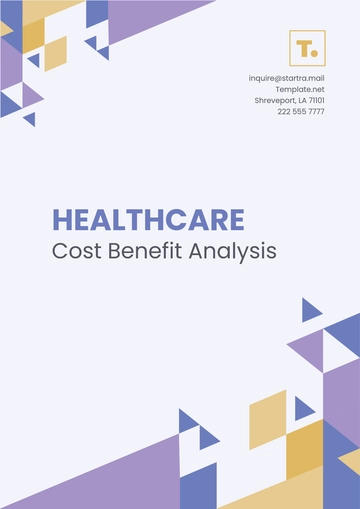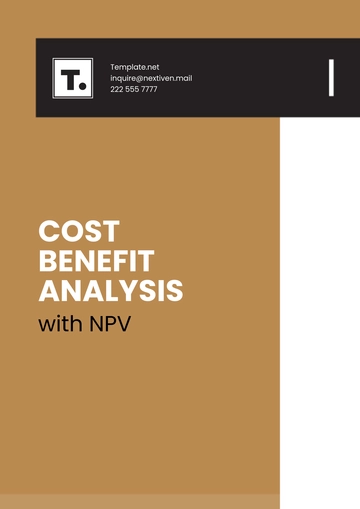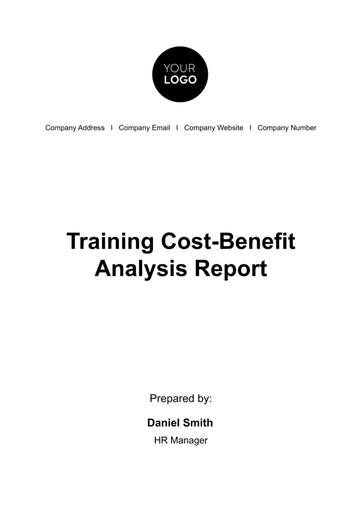Free Financial Cost Compliance Analysis

I. Overview
In the contemporary business environment, ensuring financial integrity and compliance with cost-related policies is crucial for organizational success. This analysis aims to thoroughly assess and improve the effectiveness of financial controls within the organization. The goal is to systematically examine various aspects of cost compliance, identify areas of enhancement, mitigate risks, and ensure alignment with internal policies and regulatory standards.
II. Objectives
The primary objectives of this analysis are to:
Evaluate adherence to internal financial policies.
Ensure compliance with industry-specific regulations and legal requirements.
Assess budget adherence and identify areas for improvement.
Enhance the authorization process for financial transactions.
Review contract compliance and alignment with financial terms.
Identify and mitigate potential financial risks.
III. Policy and Regulatory Compliance Analysis
A. Internal Policies Adherence
Review of Financial Policies and Procedures
The examination reveals a comprehensive and well-structured framework governing financial policies and procedures, instilling confidence in the organization's financial governance.
Adherence to Internal Controls and Guidelines
The company satisfactorily adhered to internal controls and guidelines which signifies a disciplined financial environment, promoting transparency and accountability within the organization.
Policy Language Clarification
Identification of areas where policy language could be clarified ensures that policies are easily comprehensible, minimizing the risk of misinterpretation.
B. External Regulations Compliance
Industry-Specific Regulations
Thorough verification affirms the organization's compliance with industry-specific regulations, reflecting a commitment to meeting external standards.
Adherence to Legal Requirements
The analysis had unveiled a strong adherence to legal requirements governing financial activities demonstrating a commitment to legal compliance, reducing the risk of regulatory issues.
Proactive Approach to Regulatory Standards
The organization's proactive approach to regulatory standards indicates a forward-thinking stance, ensuring readiness for any changes in the regulatory landscape.
C. Alignment with Standards
Rigorous Evaluation of Financial Standards
Rigorous evaluation affirms the organization's alignment with recognized financial and accounting standards, highlighting a commitment to industry best practices.
Adherence to Industry Benchmarks
Alignment with established industry benchmarks signifies the organization's commitment to excellence, positioning it favorably within the industry.
IV. Budget Adherence Analysis
Effective financial management hinges on aligning actual expenditures with the established budget. The table below provides a summary of the analysis:
Expenditure Category | Budgeted Amount | Actual Expenditure | Variance |
[Office Supplies] | [$12,000] | [$15,000] | [$3,000] |
The analysis reveals notable variances between the budgeted amounts and the actual expenditures. Upon scrutinizing these variances, it is evident that adjustments or corrective actions may be necessary to align actual expenditures with budgetary constraints. The analysis highlights that some categories also surpasses its budgeted amount while others are lower than the budgeted amount, suggesting a potential requirement for reassessing spending patterns or reallocating resources to ensure expenditures align with budgetary constraints.
V. Expense Authorization
A. Authorization Process Evaluation
Process Effectiveness Assessment
A comprehensive evaluation of the authorization process for financial transactions was conducted, revealing its overall effectiveness in maintaining financial integrity.
Approval of All Expenses
Verification indicates that all expenses underwent the proper approval process, aligning with established protocols and policies.
Identification and Resolution of Unauthorized Expenditures
Instances of unauthorized expenditures were identified and promptly addressed, mitigating potential financial risks.
B. Policy Adherence in Authorization
Adherence to Internal Policies
The authorization process demonstrated a high level of adherence to internal financial policies and procedures, ensuring compliance at every step.
Compliance with External Regulations
External regulations governing authorization processes were adhered to, ensuring legal compliance and minimizing regulatory risks.
C. Training and Awareness Programs
Effective Employee Training
Ongoing training programs were found to be effective in educating employees about the authorization process and fostering a culture of compliance.
Clear Communication of Authorization Policies
Communication strategies effectively ensured that employees were well-informed about authorization policies and procedures.
Initiatives for Continuous Improvement
Ongoing initiatives showcased a commitment to continuously improving the authorization process, enhancing the organization's overall compliance culture.
VI. Contract Compliance
A. Review of Contracts and Agreements
Comprehensive Financial Transaction Review
A thorough review of contracts and agreements related to financial transactions was conducted, ensuring alignment with organizational goals.
Confirmation of Mutual Obligations Adherence
Both parties involved were confirmed to be fulfilling their obligations as outlined in contracts, fostering a mutually beneficial relationship.
Alignment of Financial Transactions with Contract Terms
Financial transactions were assessed against contract terms, ensuring consistency and compliance with the agreed-upon conditions.
B. Risk Assessment in Contracts
Identification of Contractual Risks
Potential financial risks associated with contracts were identified, paving the way for effective risk management strategies.
Evaluation of Risk Mitigation Measures
Existing measures to mitigate identified contractual risks were evaluated, providing insights for further strengthening risk management practices.
Documented Contractual Changes
Changes made to contracts during the analysis period were documented, ensuring transparency and compliance with established processes.
C. Communication and Transparency
Stakeholder Communication Effectiveness
Stakeholders were effectively informed about contract terms, changes, and compliance requirements, promoting transparent communication.
Transparency in Contractual Processes
Processes related to contract compliance were found to be transparent, facilitating open communication and accountability.
VII. Risk Management
A. Identification of Financial Risks
Risk Identification Process
The analysis successfully identified potential financial risks, encompassing market volatility, credit risks, and operational challenges.
Assessment of Risk Magnitude
A meticulous assessment determined that high-impact risks such as currency fluctuations and supply chain disruptions pose significant challenges.
B. Monitoring and Reporting Systems
Effectiveness of Monitoring Systems
Monitoring systems were found to be effective, promptly detecting shifts in risk indicators and ensuring proactive risk management.
Reporting Accuracy and Timeliness
The risk reporting systems demonstrated high accuracy and timeliness, enabling stakeholders to make informed decisions based on real-time data.
C. Crisis Management Preparedness
Crisis Response Plan Evaluation
The evaluation revealed a robust crisis response plan, detailing clear protocols for financial emergencies, including liquidity crises and economic downturns.
Simulation Exercises Effectiveness
Simulation exercises effectively tested the crisis response plan, identifying areas of improvement and ensuring the organization's readiness for various scenarios.
VIII. Financial Reporting
A. Accuracy of Financial Statements
Comprehensive Financial Statement Review
The comprehensive review of financial statements affirmed their accuracy, with all reported figures aligning with underlying transactions and accounting principles.
Identification of Reporting Discrepancies
Discrepancies in financial reporting were minimal, and those identified were promptly investigated, revealing minor errors in data.
Corrective Measures and Adjustments
Corrective measures, including reconciliations and adjustments, were implemented to rectify identified reporting discrepancies, ensuring the integrity of financial statements.
B. Timeliness and Consistency in Reporting
Assessment of Reporting Timeliness
Reporting processes demonstrated high timeliness, with financial reports consistently generated within established timelines, providing stakeholders with timely insights.
Consistency in Financial Reporting
Consistency was observed in the application of accounting principles across financial reports, ensuring a uniform and reliable presentation of financial information.
C. Compliance with Regulatory Standards
Verification of Regulatory Compliance
Thorough verification processes confirmed full compliance with relevant regulatory standards and accounting principles, safeguarding against potential legal risks.
Continuous Compliance Monitoring
Strategies for continuous monitoring of compliance, such as regular internal audits and periodic reviews, were identified to sustain a proactive approach to regulatory adherence.
IX. Documentation and Record Keeping
A. Documentation Practices
Documentation Review
A comprehensive review of documentation practices was conducted, encompassing financial transactions, policies, and procedural manuals.
Consistency in Documentation
Documentation consistency was observed across various departments, ensuring uniformity and ease of retrieval during audits.
Identification of Documentation Gaps
Identified gaps in documentation practices were minimal, with only minor instances requiring additional details or clarification.
B. Record Keeping
Record Accessibility and Retrieval
The analysis confirmed the effectiveness of record-keeping systems, allowing for easy accessibility and retrieval of essential financial records.
Data Security and Confidentiality
Robust security measures were observed, safeguarding financial records against unauthorized access and ensuring the confidentiality of sensitive information.
Audit Trail Clarity
Audit trails were clear and well-maintained, providing a transparent view of the progression of financial transactions and supporting accountability.
X. Action Plan and Follow-Up
A. Implementation of Risk Mitigation Strategies
Immediate Implementation
Immediate implementation of recommended risk mitigation strategies, including diversification measures, enhanced credit risk assessments, and contingency planning.
Regular Monitoring and Adjustments
Establish a system for regular monitoring of implemented strategies, allowing for timely adjustments.
Communication of Risk Management Protocols
Conduct staff training sessions to communicate updated risk management protocols, ensuring organizational-wide adherence.
B. Enhancement of Crisis Preparedness
Refinement of Communication Protocols
Refine communication protocols within the crisis response plan, emphasizing clarity and effectiveness in conveying critical information during financial crises.
Frequent Simulation Exercises
Schedule more frequent simulation exercises to test the crisis response plan, allowing for continuous improvement and heightened preparedness.
Documentation and Accessibility
Update and ensure accessibility of crisis response documentation, ensuring all stakeholders can easily reference and follow established procedures.
C. Optimization of Financial Reporting Processes
Automation Implementation
Implement automation tools for routine financial reporting tasks, streamlining processes and reducing the risk of manual errors.
Regular Training on Reporting Procedures
Conduct regular training sessions on financial reporting procedures, ensuring consistent understanding and application of accounting principles.
Feedback Mechanism Establishment
Establish a feedback mechanism for continuous improvement in financial reporting processes, encouraging staff to contribute insights and suggestions.
D. Documentation and Record Keeping Enhancement
Update and Standardize Documentation
Initiate a comprehensive update of documentation, standardizing formats and ensuring alignment with current policies and procedures.
Training on Documenting Best Practices
Conduct training sessions on documenting best practices, emphasizing the importance of accuracy, completeness, and consistency.
E. Ongoing Monitoring and Auditing
Establish Regular Monitoring Protocols
Establish protocols for ongoing monitoring of financial processes, ensuring real-time detection of any deviations or anomalies.
Periodic Internal Audits
Schedule periodic internal audits to assess compliance with established financial and regulatory standards, providing insights for continuous improvement.
XI. Conclusion
In conclusion, the analysis has provided valuable insights into the organization's financial processes and compliance mechanisms. The examination of expense authorization, contract compliance, risk management, financial reporting, documentation, and record-keeping revealed commendable practices as well as areas for enhancement. The identified strengths, including robust risk identification and crisis response plans, serve as pillars supporting the organization's financial integrity. Simultaneously, recommendations for improvements in documentation practices, financial reporting processes, and ongoing monitoring underscore the commitment to continuous enhancement. The action plan outlined for risk mitigation, crisis preparedness, process optimization, and documentation enhancement will be pivotal in elevating the organization's financial cost compliance standards. Overall, this analysis lays a foundation for sustained financial excellence, ensuring resilience, transparency, and proactive risk management in the ever-evolving business landscape.
- 100% Customizable, free editor
- Access 1 Million+ Templates, photo’s & graphics
- Download or share as a template
- Click and replace photos, graphics, text, backgrounds
- Resize, crop, AI write & more
- Access advanced editor
Ensure cost compliance with the Financial Cost Compliance Analysis Template from Template.net! Optimize processes with the AI Editor Tool, strategically incorporated in this editable template. Tailor it dynamically to reduce compliance risks and enhance operational efficiency. Achieve financial compliance with a customizable solution. Get your analysis done in minutes today!





























